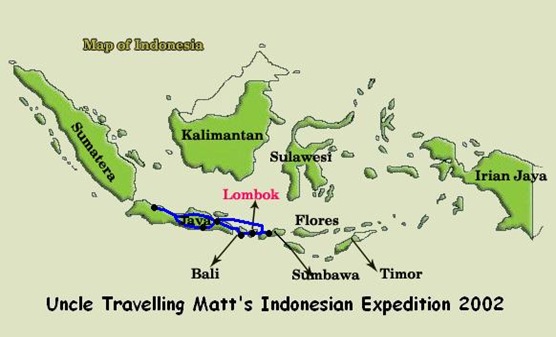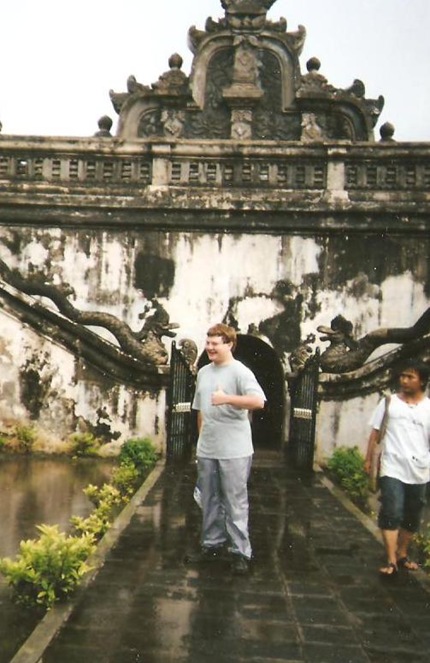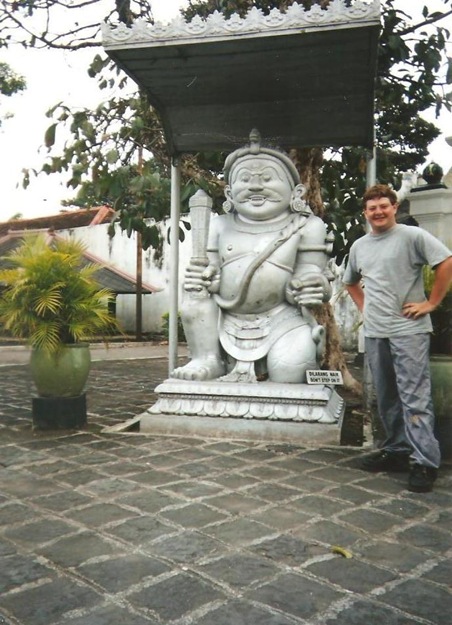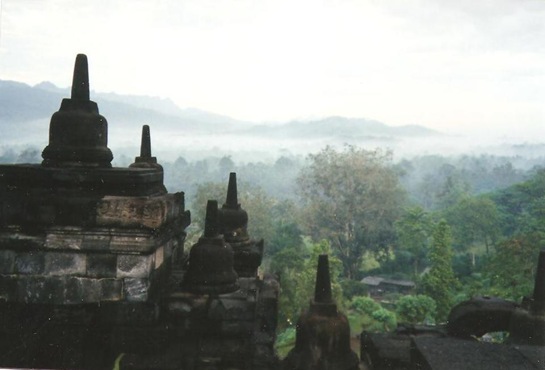Greetings!
Another week has passed and January 2013 has proven to be the most successful in the short history of UTM with over 2,600 visitors! Thanks for keeping on coming!
Some visitors have been guided to us by this post on the blog ‘A Nevada Yankee in King Zog’s Court’. I checked out the blog which is all about everything Albanian and I have to admit that it’s rather good and I’m sure that I’ll be having a chat with its webmaster before my next visit to the Land of the Eagle. And in that vein, please revisit my ‘Albanian Excursions’ travelogue which I have recently updated with loads more pictures.
But back to today’s offering and it’s the penultimate installment of ‘Dirty Magazine’. The final and seventh part will be posted next week just before I jet off to India.
Can’t wait!
Keep travelling!
Uncle Travelling Matt
Links to all the parts of this travelogue
Although it’s modern-day population is less than half a million, Yogyakarta, (or ‘Yogya’ for short), is the cultural and political heart of the island of Java, if not of Indonesia as a whole. What that means to the tourist such as I, is that there is plenty to see and do, and what’s more, plenty of other people seeing and doing it. This place truly was tourist central, which meant that near the railway station was situated a large ‘Hippyville’ full of cheap hotels and traveller restaurants. I had ensconced myself in one establishment named Hotel Karunia. This place was reasonably priced and had character and so I was happy and after sitting in bed for some time reading Erskine Childer’s excellent ‘Riddle of the Sands’ I decided to get up and sample the delights of Java’s number one spot for culture vultures.
Most of the action, (as it were), seemed to be centred around an area called the Kraton, a large enclosed city-within-a-city type place to the south of the hotel, so I decided that that was the direction in which I should head. Firstly though, I had to organise my trip to Borobudur.
Borobudur is the reason why most people come to Yogya. It’s a large Buddhist temple complex situated around twenty miles from the city and dating back from 750-850 AD And if that wasn’t enough for this Wonder of the World, Michael Palin visited the place during his trip around the Pacific Rim. Being a fan of the old Monty Python funnyman, I simply had to go, and thus I booked myself upon a tour, starting at an ungodly hour the following morn, to see the ruins and also some Hindu temple that according to the bloke who flogged the package to me, were “very interesting for you to see, mister.” Whatever. In for a penny, in for a pound, and that done, I hired a cyclo and made my way, (or rather, somebody made my way for me), to the legendary Kraton.
This Kraton, it turned out, was rather similar in concept to the many ancient walled cities to be found all over Europe, in that it had obviously been the original Yogyakarta, and the modern-city had outgrown it. Unlike most European cities though, it was square and ordered and smack in the middle of it all stood the city’s number one tourist attraction, the Sultan’s Palace. Yogya was founded by the first Sultan in 1755 and his family have ruled ever since. Even today, this Royal figure is alive and kicking politically speaking. During the Revolution against the Dutch he helped the rebels and was thus rewarded with Yogya being given the status of a special territory, answerable direct to Jakarta and not the Central Javan government. Under Suharto’s government the popular ninth sultan was Indonesia’s vice-president but that didn’t stop his son, the tenth sultan from supporting the reformers whom overthrew that government. When Jakarta tried to oust him from his seat of power in Yogyakarta in 1998 the people took to the streets. He was soon reinstated.
Great as the Sultan might be, I have to say, I wasn’t overly impressed with his palace. Perhaps it’s because I’m a European and I don’t truly understand the Asian style, (I was distinctly unimpressed with the famous yet spartan Nijo-jo, the residence of the Shogun, in Kyoto), but it all seemed to me a little bare and soulless. Upon entry, (through one of the two gates, one male, one female), I found myself in amongst some pavilions containing musical instruments. After that was an exhibition of paintings and photographs of sultan’s past and present and then the central pavilion, which was all in gold, (that was impressive), and contained the great man’s throne. Cool enough, but that was it. Hoping that the next attraction might be a little more attracting I left the palace confines and fought my way through the vendors and hawkers to my cyclo driver who then escorted me on towards the Water Castle.
The Water Castle was not what I’d expected. The cyclo stopped in the midst of some backstreets and we were met, (surprise, surprise), by the pedaller’s cousin who spoke English and was knowledgeable on the locality. No doubt this would come at a price but it was obvious that I would need a guide to show me around the place and he would have to do. The Water Castle was once a fantastical pleasure park of canals, palaces and pools built for the Sultan. In it’s heyday it must have been amazing. Nowadays however, humanity had encroached upon the realm of the Sultan’s and what remains are left today are sandwiched amongst the dwellings of the people and the batik shops that they run, ready to extort money from tourists such as I. The remains however, were impressive. Long tunnels under the streets, a huge open-air mosque where the Sultan used to listen to the words of the divine, and most impressively of all, the fully restored bathing pools.
The Water Castle, Yogyakarta
My entry into these was delayed by a heavy shower which forced us into a roadside stall where I chatted with the owner about the Premier League, the World Cup and other aspects of God’s greatest gift to mankind. When the rain abated we bade farewell and I moved onto what was surely the highlight of Yogyakarta. In days gone by the wives and concubines of the Sultan lazed about in the pools, whilst he kept a close eye on them all from a small tower situated between the main baths. Every so often he might deign to invite one of the beauties up to him where they would sit and talk about the Premier League of the day, (I assume). The place was the perfect setting for the sexual fantasies of most red-blooded males. Who hasn’t dreamed about owning a harem of beautiful young women? In reality it probably wouldn’t be so amazing, could you imagine the back-biting, nagging and bitching that would have gone on there, and the complex did suffer from a damp problem which was no doubt not new. Nonetheless, the fantasy remains, and for a few moments in the Sultan’s tower, I closed my eyes and indulged in it.
But alas, reality steals upon us all too quickly, and my guide and I soon left the baths, and proceeded to a batik gallery, (he made sure that was on the itinerary. Having indulged in some sinful fantasies of the flesh, I decided that it was now time to purge the mind of ungodly thoughts. Ever since entering Indonesia I had wanted to set foot inside a functioning mosque, but was unsure of the decorum involved, would they welcome a foreigner? But now I had a guide, so what better time? I suggested it to my new special friend, (who was friendlier than ever since I’d bought some batik), and he agreed to take me to his local house of worship which was nearby. In fact, he more than agreed, he was quite enthusiastic, I don’t think anyone had ever asked to see something of contemporary Yogyakarta before.
The mosque’s name, sadly I did not write down, but it was only the name of the kampung (district), anyway. It was a pleasant place, cool and peaceful. My guide showed me how the devout wash for prayer and of the two sections where both men and women pray to Mecca. We then entered the building, (which was open at the sides, perhaps pavilion is a better description), and went through the rituals, which involved standing, crossing one’s arms in front of oneself, kneeling and then pressing one’s head to the floor several times in an order too complex for me to remember. As we exited the students from the Mosque’s Madrassah were coming out of class and I had my photo taken with two cute jilbab-clad little girls.
My guide, it turned out, was enthusiastic about his faith, though not dogmatic. He had been brought up a Christian, but had converted so as to marry his wife. At first this was only a formal conversion, but gradually he had come to truly embrace his new faith, which he said offered more spiritual comfort and security than the less-strict Catholicism of his youth. His story was an interesting one, and in my opinion, it displays well the singular strength and weakness that Islam has, it’s strictness. More than any other faith, Islam governs its follower’s lives, and all rules for living are set down in the Koran and the Hadiths, (sayings of the Prophet). This can be a boon to many that cling to its guidance and established certainties. However, it makes it resistant to change and strict regularity does not suit all believers, myself included. But to countless millions it does provide what they want and gives comfort to many a home across the world. And at the end of the day, that is a fantastic thing which far outweighs the death and destruction caused by a few fanatics and so heralded in the Western press.
Leaving the mosque in the rain we climbed once more into the cyclo and then set forth to somewhere that the guide had been trying to get me to all day, the theatre where the Ramayana Ballet performances are held and more importantly, the tickets are sold. Going to the ballet interested me, I’d never been to the ballet before and I’m always one to try everything once, (and where cheaper to try it?), and what’s more, of all the world’s major faiths, Hinduism is the one that I know least about. A staged version of the Ramayana might well be a good introduction. Nonetheless, I was far from sure that I would be purchasing a ticket, especially since I didn’t like the way in which I was driven there whether I wanted it or not. However, the sweet smile of the young lady behind the counter soon convinced me, I’m sorry to say that the world’s oldest marketing ploy worked once again.
I was the first to be picked up by the theatre’s minibus that evening, but the driver and myself were soon joined by guests from the finer hotels in town. Firstly came a Belgian with his Singaporean girlfriend who were in Bali for a holiday and had taken a three-day excursion to Yogya. Then came the Japanese. I couldn’t believe it, as I am not the most enthusiastic Japanese-speaker, (nor the best), but after almost two weeks sans-Oriental company I was eager to speak Japanese once more. They appreciated it too, since (surprise, surprise), they knew no other tongue, and so together, (with the English-speaking Belgian and Singaporean), we chatted and sat together at the ballet. Then the lights dimmed and the show began.
Outside the Ramayana Theatre
At the entrance to the open-air theatre we had been given an explanatory leaflet each, (in the language of our choice), telling us what the hell was going on. We needed it! The costumes were amazing, as was the dancing and the jumping over fire, but as a means of telling a story, I found the medium of ballet sadly lacking. Perhaps I’m a cultural ignoramus, I know not, but give me a book, or the TV series anyday. Nonetheless, the experience was enjoyable, the dancing flawless, and I can now say that I’ve been to the ballet, which sounds quite cultured even in a broad Potteries accent. Besides, we got a photo with the main characters at the end and it was cheap. What more could one ask for?
In the car going back, I asked a couple from Nagoya how much they had understood of it all. “Half?” asked I.
They looked at each other guiltily and then with typical Japanese politeness and understatement, replied.
“Maybe.”
I retired straight after the Ramayana Ballet intending to get a good night’s sleep in preparation for the following morning’s early start. However, after a mere five minutes between the covers, I felt the need to get up and use the bathroom. I knew at once that this was not good, though equally, not undeserved.
Whenever I travel anywhere I rarely take any notice of the advice given by travel agencies and guides regarding steering clear of the local food and water. Admittedly this time I’d stayed clear the latter on the whole, (although I’d still drank tea on the street and cleaned my teeth with it, being careful not to swallow), but two toilet visits on, it was fast becoming clear that my pathetically inadequate precautions had failed to ward off the gremlins.
I have fallen prey to food poisoning twice before, in Egypt and Cambodia, and neither time was it fun. It attacks in waves and causes sickness, diarrhea, an aching body, an inability to consume food and nightmarish, chaotic dreams whilst sleeping. The bout in Cambodia was the worst, since I had to endure a ten-hour bus journey before I could finally get to bed and sleep it off. Food poisoning cannot be cured or staved off, you’ve just got to sit, (or sleep), it out. It’s hell, but twenty-four hours later, it’s gone. Problem was, I didn’t have twenty-four hours, in less than ten I was due to visit Borobudur. I spent the rest of the night tossing and turning in a chaotic sleep, in-between frequent visits to the little men’s room and stretches sat up sweating in bed. Would I manage to go tomorrow? At times it felt like I would not even be able to make it downstairs, let alone to a Buddhist holy site twenty miles distant, whilst during the times when the illness abated a little, I reminded myself that it was a wonder of the world and that I’d probably never have another opportunity to go there. After all, I’d managed ten hours on a bus in Cambodia, what problem would one be here?
Despite a lack of sleep and substance, when the time to leave came, I felt a little better. As I said before, food poisoning comes in waves and the tide was presently out, so I struggled out of bed and into the waiting minibus where I was soon joined by an Irish couple, a pair of Dutchmen and a girl named Margot from Utrecht. The journey was uneventful. I felt well enough to talk to one of the Netherlanders about his country and to survey the passing scenery, but by the time that we had stopped and were walking towards the entrance, it was fast becoming clear that another wave of sickness was about to hit the beach.
At the gate I got in as a student, pretending that my Japanese ID card was a Student ID from Kyoto University, (always worth a try), but my spirits were not raised much. By now the food poisoning was in full flow once more, the germs enjoying one hell of a party in my system. I struggled to the foot of the imposing stone pyramid that is Borobudur, but alas, that was all that I could manage. Whilst the others climbed on up, I merely sat on a bench at the foot like someone’s grandma on a family trip to the seaside, whilst a bored guide who was hoping, (in vain), for a tip, told me all about the Buddhas at the top that I could not see.
Not being able to stand that too long I excused myself, went round to the corner of that great monument and threw up on it. During the aftermath, whilst gazing up at that testament to human ingenuity and faith, I mused upon whether it was the most spectacular vomiting spot that I’d ever chosen. It probably was, although I must admit to blowing chunks over Leeds Town Hall several years ago. Feeling better physically (from being sick) and mentally (for having achieved something vomitally speaking), I made my way back to the bench and looked meaningfully upon Indonesia’s number one attraction once again.
Top 10 Monuments on earth to throw-up over: No. 4: Borobudur
Despite the early hour (seven) the tourists were already starting to arrive in droves. A party of nut-brown schoolchildren and some traveller-types and, Oh my God! What was that? The most gorgeous blonde upon God’s fair earth walked past in front of me. Now, I’m not really a blondes kind of guy, much preferring the Mediterranean look, (by the by, there was an aesthetically-pleasing group of Italian tourists there too), but when you do come across a good blonde, it is something to behold.
And this fair maiden was definitely out of the top drawer!
I was just musing as to where she might hail from, (definitely European, you can tell by the fashion. Probably not Dutch, maybe German though a little small in stature, probably Danish or Swedish), when another vision of blonde femininity appeared before mine eyes. Sadly however, a less alluring one.
“You are looking very sick,” said Margot from the minibus.
‘No shit, Sherlock,’ thought I. But of course one is too polite to say so.
“I was sick before, it was terrible experience.” However I was feeling, my blonde muse had disappeared up the temple and I was glad of the company. We walked back down the hill together and stopped at one of the many restaurants by the car park for a drink. Margot turned out to be interesting but unfortunately, very depressing too. “I am travelling now,” she announced. “It is the best experience of my life.”
“Oh really, where did you start?”
“To start with I flew into Singapore.”
“How is Singapore, I’ve never been?”
“Terrible, I hated it. It was very expensive too.”
“Oh. And where did you go after that?”
“Kuala Lumpur.”
“Oh yes, I’m thinking of going there. Did you go up the Petronas Tower?”
“No, they only have a few tickets each day and when we got there they’d ran out. Didn’t do much else either, it was a horrible place. I was glad to move on.”
And so on and so forth. In her three months of travelling, Margot from Utrecht had met no one that she really liked, stayed in no hostel or hotel that she’d recommend and gone to no place that she’d enjoyed. And this was the best experience of her life! I didn’t want to stick around to hear about the bad times. Besides, the minibus was leaving soon.
I was taking a different bus back to the one that I’d taken going, as that was proceeding onwards to another temple and I wanted only to proceed back to bed. I climbed into bus number two and was surprised to find myself face to face with a glimpse of paradise; the blonde muse from the temple!
The Vision of Heaven turned out to be friendly, Danish, (Yes, guessed right!), and came with a chatty friend. That was good since it meant that I could stare at them both whilst pretending to listen to the latter. Actually, that’s not entirely true, I did indeed listen to the friend and the Danish Divinity since they turned out to be rather interesting. They were both teaching English in Surabaya and had been on Java for six months. We talked of Surabaya, English teaching, (I’m sorry, I know it’s sad, but it’s true. I meant the girl of my dreams and had a conversation about class sizes), England, (Heavenly Creature loved pub culture, I almost proposed there and then!), and then moved onto a mystery that has been bugging me ever since I first set foot in South-East Asia.
We were talking about popular culture in Indonesia. I’d just wowed them with my Doraemon knowledge, (for those not in the know, he’s a blue cat-like robot with no ears who helps a stupid kid called Nobita and is to Asia what Mickey Mouse is to the States), when I asked what music the youth of Surabaya are into.
“It is strange,” said the sublime Scandinavian in her sultry soothing accent, “but they all like ‘Michael Learns to Rock’.”
Friend agreed.
‘Michael Learns to Rock’. Have you ever heard of them? Oh what a surprise, you haven’t, join the bloody club. When I was in Vietnam however, everyone, (and I mean everyone), was mad about them. Who are they? A Michael Bolton-esque soft rock outfit. Where are they from? Vietnamese people seemed unsure. “America?” So I asked some of our friends from across the pond. “Michael Learns to Rock?”
“Who?” answered they.
Perhaps they were Canadian; they sometimes have strange pop tastes.
“Who?” answered the ones clad in maple leaves.
The identity of this group remained an unsolved mystery that I thought little of until I went to the Philippines.
“Michael Learns to Rock,” said the guy with the mike. “Sing this Michael Learns to Rock song for me please.”
“I’m sorry, but I can’t.”
“You can’t! Why not?”
“I don’t know it.”
“But they’re the biggest group in the Philippines! How can you not know this song, it was number one for eight years!” Or something like that anyway.
“Who exactly are ‘Michael Learns to Rock’?” I asked the Dansk Deity, “And where are they from?”
“Oh, they are from Denmark, but no one there really listens to them. Here though, everybody likes them. It’s strange.”
“Strange,” I agreed, gazing into her deep blue eyes.
The food poisoning had abated for a while, but it was coming back. Luckily, today’s bus journey was one hour, not ten, and the hotel was reached just in time for me to crawl into bed and fall into a restless slumber. Awaking mid-afternoon, I felt somewhat better and so I ventured out for a sandwich in Hippyville. Sat in a restaurant, I was surprised to see Margot walk by.
“Are you better now?” she asked.
“A little,” I replied honestly. New waves of food poisoning were approaching post-tomato sandwich though. “How was the other temple?”
“Disappointing.”
Hmm. I stumbled back to my bedroom toilet thanking God that however bad I might be feeling at that moment in time.
At least I wasn’t Margot from Utrecht.
Next part: Pt. 7: Jakarta and home…






No comments:
Post a Comment